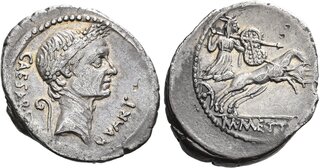| Numismatica Ars Classica > Auction 143 | Auction date: 7 May 2024 |
| Lot number: 379 Price realized: This lot is for sale in an upcoming auction - Bid on this lot  | Show similar lots on CoinArchives Find similar lots in upcoming auctions on |
| Lot description: The Dioscuri Collection. The Roman Republic. C. Iulius Caesar and M. Mettius. Denarius 44, AR 19 mm, 3.20 g. Wreathed head of Caesar r.; behind, CAESAR [DICT] and lituus; before, QVART. Rev. Juno Sospita in galloping biga r. holding figure-of-eight shield in l. hand and brandishing spear in r. Below horses, M·METTIVS. Babelon Julia 31. C 36. Sydenham 1057. Alföldi Caesar, pl. VII, 18 (these dies). Sear Imperators 98. RBW –. Crawford 480/2a. Extremely rare and in unusually fine condition for this difficult issue. A lovely portrait and a light iridescent tone. Two insignificant banker's marks on obverse and reverse field, otherwise extremely fine Ex NAC sale 114, 2019, 506. This coin marks the beginning of the monarchical behaviour that would cause many members of the senatorial class to turn against Julius Caesar and assassinate him on the Ides of March. The Romans were long opposed to all trappings of kingship both in memory of the expulsion of Tarquinius Superbus, which allowed for the creation of the Roman Republic, and as a practical means of preventing the subversion of that republic. As a feature of this old anti-regal policy, it was Roman custom to never depict a living man on their coins, because this would be too much like the practices of contemporary Hellenistic kings. It was therefore very shocking to the public, and especially individuals of strong republican sentiment, when denarii like this began coming out of the mint in early 44 BC. The obverse is a clear portrait of Caesar as dictator for the fourth time executed in an excellent veristic style that does not shy away from representing his physical flaws. Due to the quality of its execution, this is probably the most desirable issue of all of Caesar's portrait coins. The dictator is shown here with the corona aurea awarded for his triumphs, but which he took to wearing at all times to cover up his increasing baldness. A lituus, the staff of the augur, appears behind the neck specifically advertises his appointment as a member of the college of augurs in 47 BC, but may also allude in more general terms to Caesar's religious roles. He had been pontifex in 73 BC and previous religious positions as pontifex maximus in 63 BC, and showed a great interest in using his sacred roles as a means of bolstering the legitimacy of his sole rule. The reverse type features Juno Sospita and represents the influence of the moneyer M. Mettius on the coin design. Juno Sospita ("the Saviour") was a form of the important goddess that was especially venerated in the Latin city of Lanuvium, the ancestral home of the gens Mettia. She was adopted into the Roman pantheon early on and had her own temple on the Palatine Hill in the fourth century BC. This nod to Mettius' family represents a last gasp for traditional moneyers as types related to Caesar came to dominate both sides of the coins. The disappearance of moneyers' influence on Roman coins only accelerated after his death and the coming of the civil wars resulting the creation of the Empire. Estimate: 15000 CHF |  |



